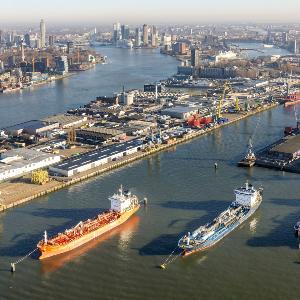Coastal cities and adaptation to climate change: progress and failures
26 Aug 2024
A new study investigating the status of climate change adaptation in coastal cities worldwide discovers progress and shortcomings.
26 Aug 2024
A new study investigating the status of climate change adaptation in coastal cities worldwide discovers progress and shortcomings.

Rotterdam is an example of medium-scale adaptations. | © IMAGO / Pond5 Images
Coastal cities play a central role in the global economy and exercise important societal functions. At the same time, they are strongly affected by the consequences of climate change. Accordingly, they have a key part to play in global adaptation to climate change. To gain an overview of the current state of adaptation, an international team lead by LMU geographer Professor Matthias Garschagen has analyzed the published scientific evidence.
In their study, the researchers investigated whether and how the adaptation of cities addresses risk factors – such as rising sea levels, storms, floods, and heat – and the exposure and vulnerability of population, infrastructure, and ecosystems.
On the one hand, the results published in the journal Nature Cities show that knowledge is unevenly distributed. Many investigations are centered on cities in the Global North, while cities in the Global South receive much less attention from researchers. We need to dig deeper into the reasons for this discrepancy, says Garschagen.
Nonetheless, the researchers were able to include 199 cities from 54 countries in different income groups in their study. They discovered that adaptation measures chiefly concerned sea level rises, floods, and, to a lesser extent, storm tides, cyclones, and erosion. Technical and institutional measures such as extensive dikes or adaptations to urban planning are more common in more prosperous regions of North America and Europe, for instance, whereas behavior-related measures predominate in Africa and Asia, with affected households and companies left to their own devices.
The researchers found some examples of far-reaching adaptations in highly developed economies and small island nations. In Singapore, Hong Kong, and some Swedish cities, for example, the existing infrastructure is being augmented by preventive measures and ecosystem-based approaches. Progress in planning and new laws also point to adaptation at a deeper level.
Meanwhile, there are examples of medium-scale adaptations, such as cross-sectoral risk management plans and institutional adaptations in places like the Netherlands (Dordrecht, Rotterdam) and Finland (Helsinki) as well as middle-income Asian countries. The sample features just one city in a low-income country with medium-level adaptation – namely, Maputo in Mozambique, which incorporates adaptation measures in its development plans and has defined clear responsibilities for dealing with the impacts of climate change.
Overall, however, the researchers established that the adaptation measures in the majority of the cities investigated across all income groups and regions are insufficient in depth, extent, and speed. Moreover, they found scant indications for the sustainable reduction of risks through adaptation.
“Our results show a need to catch up at all levels,” explains Garschagen. “There is little transformative change, involving a fundamental rethink of risk management.” This confirms the impression from ongoing LMU empirical research projects in coastal cities. Cities often try to optimize disaster management based on past experiences, without asking the deeper question as to whether these approaches will continue to be viable in the future. One example is Ho Chi Minh City, which is expanding strongly into flood-prone areas and where infrastructure is being built that will be exposed to future disasters in around 50 to 70 years’ time. “This is highly risky development,” emphasizes the geographer.
Furthermore, the reorganization of coastal protection and restructuring of cities have long lead times before the planning processes are completed and new technologies implemented. “In view of the rapid changes underway, things are moving too slowly,” says Garschagen. There is a lot of talk, he observes, but precious little prompt implementation.
On top of this, the bases for adaptation planning are often not sufficiently quantified. Although cities consider future natural hazards such as flooding and heat, they rarely take into account future trends in their social vulnerability or spatial exposure. “And this is important,” says Garschagen, “because the Lagos or Jakarta of today will not be the same in 20 years. The changes in domains such as demography or urban growth are so rapid and extensive that we really should include them. There are large research gaps here, for sure, and we need better scenarios and modeling techniques. Another important question is at what point does it make more sense to abandon coastal protection measures and think about resettlements instead.” Indeed, researchers in Garschagen’s chair are investigating this very question in places like Manila.
Despite the challenges that abound, there are some positive developments, as the study shows. Adaptation measures are being tested and implemented in many cities worldwide and new methods are being devised. With their study, the researchers want to help cities learn from the results to date and identify gaps and weaknesses so as to improve adaptation to current and future climate impacts.
M. Wannewitz et al.: Progress and gaps in climate change adaptation in coastal cities across the globe. Nature Cities 2024